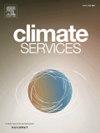利用多指数方法对旅游气候适宜性进行量化和分类的好处
IF 4.5
3区 环境科学与生态学
Q2 ENVIRONMENTAL SCIENCES
引用次数: 0
摘要
旅游气候指数用于量化、分类和比较旅游目的地的气候适宜性。大多数,如果不是全部,都是单独使用的。在使用多个指标的情况下,通常是为了证明一个指标的相对有效性。这在气候科学中是特殊的,因为对于热舒适和气候建模,多指数方法是常态。我们提倡将这种方法扩展到旅游气候学,因为多指数方法可以更全面地了解目的地的气候适宜性,从而提供广泛的旅游活动。我们通过将这种方法应用于r本文章由计算机程序翻译,如有差异,请以英文原文为准。
Leveraging the benefits of a multi-index approach in quantifying and classifying climatic suitability for tourism
Tourism climate indices are used to quantify, classify and compare the climatic suitability of tourism destinations. Most, if not all, are used in isolation. Where more than one index is used, it is often to demonstrate the relative efficacy of one index. This is peculiar within climate sciences, where for thermal comfort and climate modelling, multi-index approaches are the norm. We advocate for the extension of this approach to tourism climatology, as multi-index approaches provide a more comprehensive understanding of the climatic suitability of destinations for a wide range of tourist activities on offer. We make this argument through applying this approach to Réunion Island, a destination with diverse forms of tourism, topography and microclimates. Applying the Tourism Climate Index (TCI), Holiday Climate Index for Urban Tourism (HCIUrban), Holiday Climate Index for Beach Tourism (HCIBeach) and the Camping Climate Index (CCI) for 33 years of data across 11 stations, we demonstrate the varied outputs in terms of peak seasonal suitability across touristic attractions, the relative suitability across locations and change in climatic suitability over time. This approach is beneficial in describing the climatic suitability for tourism more accurately, identifying the nuances in suitability for different tourism types and is, therefore, a valuable approach to use in future studies.
求助全文
通过发布文献求助,成功后即可免费获取论文全文。
去求助
来源期刊

Climate Services
Multiple-
CiteScore
5.30
自引率
15.60%
发文量
62
期刊介绍:
The journal Climate Services publishes research with a focus on science-based and user-specific climate information underpinning climate services, ultimately to assist society to adapt to climate change. Climate Services brings science and practice closer together. The journal addresses both researchers in the field of climate service research, and stakeholders and practitioners interested in or already applying climate services. It serves as a means of communication, dialogue and exchange between researchers and stakeholders. Climate services pioneers novel research areas that directly refer to how climate information can be applied in methodologies and tools for adaptation to climate change. It publishes best practice examples, case studies as well as theories, methods and data analysis with a clear connection to climate services. The focus of the published work is often multi-disciplinary, case-specific, tailored to specific sectors and strongly application-oriented. To offer a suitable outlet for such studies, Climate Services journal introduced a new section in the research article type. The research article contains a classical scientific part as well as a section with easily understandable practical implications for policy makers and practitioners. The journal''s focus is on the use and usability of climate information for adaptation purposes underpinning climate services.
 求助内容:
求助内容: 应助结果提醒方式:
应助结果提醒方式:


